Gigabyte Z68X-UD3H-B3 Review
by Brendan van Varik on July 11, 2011 7:01 AM EST- Posted in
- Gigabyte
- Motherboards
- Sandy Bridge
- Z68
LAN Speed Test
LAN Speed Test is a freeware program designed for testing the network connection between two PCs on a home network. The speed of the transfer is limited by the lowest common denominator on the network, so if you have gigabit Ethernet capable computers but a 100 Mbit capable router, you are limit to 100 Mbit transfer. Note that this is really a formality – if a network port is rated at 1 Gbps, then chances are that it will hit at least 90+% of this value. The main test here is CPU usage, and how much is offloaded by the controller. For this test, we use LAN Speed Test to transfer a 1000 MB file across a home network with a 100 Mbps lowest common speed to the same machine each time, in a read/write scenario. CPU usage is taken as a visual max/average from task manager.
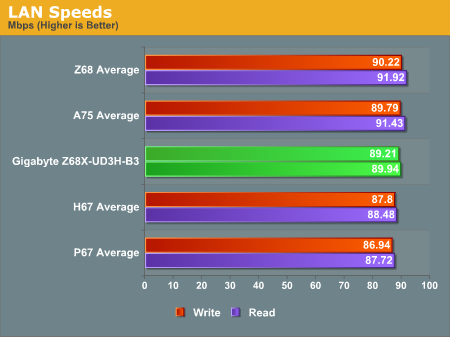
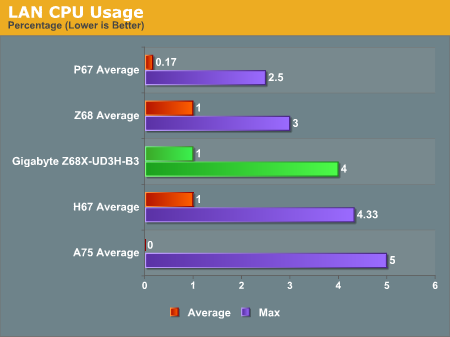
Good to see the Realtek controller doing its job properly here - the board is certainly a very strong contestant in the networking department.
DPC Latency
Deferred Procedure Call latency is a way in which Windows handles interrupt servicing. In order to wait for a processor to acknowledge the request, the system will queue all interrupt requests by priority. Critical interrupts will be handled as soon as possible, whereas lesser priority requests, such as audio, will be further down the line. So if the audio device requires data, it will have to wait until the request is processed before the buffer is filled. If the device drivers of higher priority components in a system are poorly implemented, this can cause delays in request scheduling and process time, resulting in an empty audio buffer – this leads to characteristic audible pauses, pops and clicks. Having a bigger buffer and correctly implemented system drivers obviously helps in this regard. The DPC latency checker measures how much time is processing DPCs from driver invocation – the lower the value will result in better audio transfer at smaller buffer sizes. Results are measured in microseconds and taken as the peak latency while cycling through a series of short HD videos - under 500 microseconds usually gets the green light, but the lower the better.

The Gigabyte performs very well - 120us is lower than almost all the other motherboards.
USB Speed
For this benchmark, we run CrystalDiskMark to determine the ideal sequential read and write speeds for the USB port using our 64GB Patriot SuperSpeed USB 3.0 drive. Then we transfer a set size of files from the SSD to the USB drive, and monitor the time taken to transfer. The files transferred are a 1.52 GB set of 2867 files across 320 folders – 95% of these files are small typical website files, and the rest (90% of the size) are the videos used in the Sorenson Squeeze test.
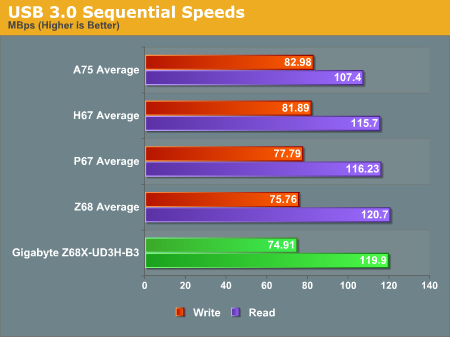
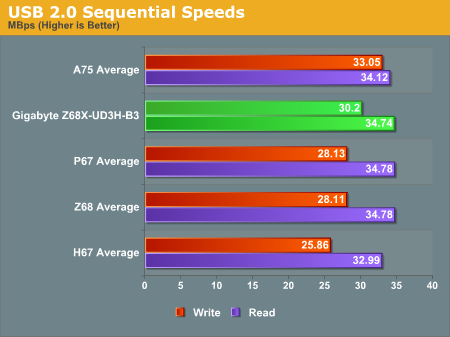
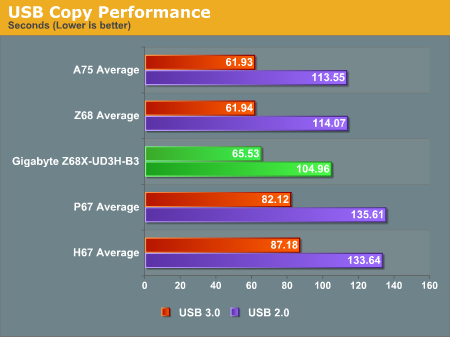
The USB2.0 speeds are more or less all the same. However, this board really shines when it comes to the write speeds. It’s on average 5MB/s faster than most of our boards we’ve tested and is only really contested by ASRocks’ XFast technology. The copy time is fairly average. On the USB3.0 side of things, the results are not anything spectacular.
SATA Testing
We also use CrystalDiskMark for SATA port testing. The operating system is installed on the SSD, and the sequential test is run at the 5 x 1000 MB level. This test probes the efficiency of the data delivery system between the chipset and the drive, or in the case of additional SATA ports provided by a third party controller, the efficiency between the controller, the chipset and the drive.
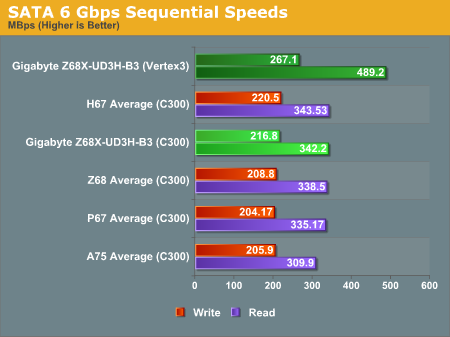
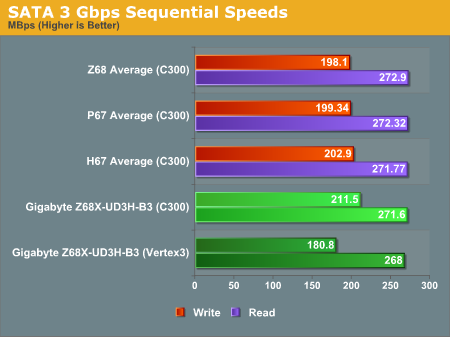










70 Comments
View All Comments
Brutus1234 - Monday, July 11, 2011 - link
I bought one of these from Newegg a couple weeks ago and I'm very happy with it.2600K with a 45x multiplier for 4.5GHz
GSKill RipSaw DDR3 ( 4 Gig ) - system recognizes memory as 2133 with enhanced profile
H70 Corsair Water Cooler
Runs great, Have not touched voltage - it's still all stock.
I've stressed tested it, running some h264 encodes, getting nearly 100% utilization on the CPU for 6hrs and never a hiccup. Temp rarely cracks 50C on the CPU. Very happy with this build
Only thing I have issues with is the Virtu Softare. It recognizes the board but I thought I was getting a licence to use it, and all I can get is a demo mode.
Patrick Wolf - Monday, July 11, 2011 - link
So they implement TouchBIOS but not a GUI? That's just being lazy. FFS, even Biostar has a GUI. Then of course there's the boot loop issue that wasted a lot of my time.http://www.overclock.net/intel-motherboards/103472...
789427 - Monday, July 11, 2011 - link
GUI for bios is *really* a waste of time. Imagine having to connect a keyboard AND a mouse to fix the machine when it breaks...That's like finding a use for a mouse in DR Dos 6.0
Awesome motherboard... lack of fan control shouldn't be too problematic.
Just had a thought though.... if CPUs were delivered in larger packages with the connectors situated off-die, with a vertical arrangement it would be possible to cool both sides of the die at once in a sandwich style cooler.
Twice the surface area to cool means that we'd be in overclocking heaven!
Now we just need Intel to decide to change the sockets again!
86waterpumper - Monday, July 11, 2011 - link
I agree with EnzoFX. If the bios does not cause a boot time slowdown that is pretty well a non issue. However, this day and age lack of fan control in the bios is more than stupid. More and more you are going to see a move to more efficient and power saving features. There is no point in a cpu clocking down and powergating and idling if the fan is going to blast on along like a jet. This is especially true for htpc use which alot are going to use the sandy bridge z68 for. Speaking of that, gigabyte is the one that actually has a z68 board out without a video out on the board at all right? What are they smoking these days :PThe0ne - Monday, July 11, 2011 - link
"Based on the benchmarks and performance figures seen in this review, it shows that you do not have to spend big amounts of money on a motherboard to get on to the Z68 platform. A motherboard that could arguably be aimed at the budget end of the spectrum has performed well "This would fit my needs perfectly. Just wondering why with the comment above it's not a "pick" from you/Anandtech? What's lacking to make it so?
jigglywiggly - Monday, July 11, 2011 - link
U GRAMMAR FARTSSTFU
READ THE ARTICLE FOR THE INFO
fb39ca4 - Monday, July 11, 2011 - link
How is $170 a budget motherboard? This is mid range territory.ratbert1 - Monday, July 11, 2011 - link
Enjoying your baptism by fire? I was going to post about the grammar, but it seems to have all be said.Mr Alpha - Monday, July 11, 2011 - link
Why not run CDM in 0xFF fill mode? Sure, the perfectly compressible data is unrealistic, but it would largely take the flash out of the equation making the benchmark purely about the interface. And when benchmarking a motherboard is it not the limits of the interfaces it provides that really matter?nemitech - Tuesday, July 12, 2011 - link
The test does;t say what version of Lucid was used on the Gigabyte MB vs the Asus one. a new version was released yesterday on the Gigabyte site:http://www.gigabyte.com/products/product-page.aspx...
I can't see any hardware reason that the Gigabyte should be slower than the Asus. Maybe there is a BIOS or Lucid driver update that brings the performance back in par. that is the probelm with reviews, issues are rarely revisited or updated leaving a bad opinion about a product.
This is defiantly a budget MB - I got mine for $105 (!) after $15 rebate, at microcenter this past weekend, with a 2500k for $180. What a bargain. :-)